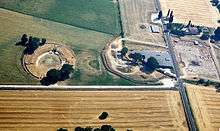Suasa
Suasa was an ancient Roman town in what is now the comune of Castelleone di Suasa, Marche, Italy. It is located in the Pian Volpello locality, in the valley of the Cesano River.
- For the butterfly genus, see Suasa (butterfly).
 Archaeological area of Suasa | |
 Shown within Italy | |
| Location | Castelleone di Suasa, Province of Ancona, Marche, Italy |
|---|---|
| Coordinates | 43°37′28.92″N 12°59′12.12″E |
| Type | Settlement |
| History | |
| Founded | 3rd century BC |
| Abandoned | 6th century |
| Periods | Roman Republic - Byzantine Empire |
| Cultures | Ancient Rome |
| Site notes | |
| Website | Sito Archeologico di Suasa (in Italian) |
History
Suasa was founded by the Romans in the early 3rd century BC, after the Battle of Sentinum (295 BC), in a territory inhabited by the Senones. The town was crossed by a secondary branch of the Via Flaminia and by the Via Salaria Gallica, which connected it to Forum Sempronii (Fossombrone) and Ostra. In 232 BC, it became a prefecture and, in the 1st century BC, a municipium.
Suasa started to decline from the 3rd century; in 409, it was sacked by Alarich's Goths during his march against Rome (see Sack of Rome). It was abandoned in the 6th century after the Gothic War, the population moving to nearby settlements.
The remains have been excavated by the University of Bologna since 1987. The edifices found include:
- an amphitheater
- a theater
- the Coiedii domus
- a late-Republican era domus
- the cardo maximus
- a necropolis
The Archaeological Park
The Suasa archaeological park is an archaeological area in Castelleone di Suasa (province of Ancona, Marche, Italy).
It includes the remains of the ancient town of Suasa, abandoned in the 6th century AD. The open-air museum of a Roman house (the Coiedii domus), of great interest because its size and architectonic complexity, can be visited in the park.
The domus was inhabited over a long period, reaching its maximum splendour in the 2nd century AD. The mosaics discovered in the interior are splendid and are the most important unitary complex of the Marches. Mythological, floral, and geometric scenes can be admired, but above all, a magnificent marble floor created with over fifteen different kinds of stone.
An avant-garde roofing and super-elevated passageways make the visit easily available.
The large amphitheatre lies at the foot of the hill. During the summer season evocative theatrical performances are held there
See also
References
- Lepore, Giuseppe (ed.). Santa Maria in Portuno nella valle del Cesano. Ante Quem. ISBN 88-7849-016-4.CS1 maint: extra text: authors list (link)
- Polverari, Alberto (ed.) (1984). Castelleone di Suasa, 1 - Vicende storiche. Tecnostampa.CS1 maint: extra text: authors list (link)
External links
| Wikimedia Commons has media related to Suasa. |